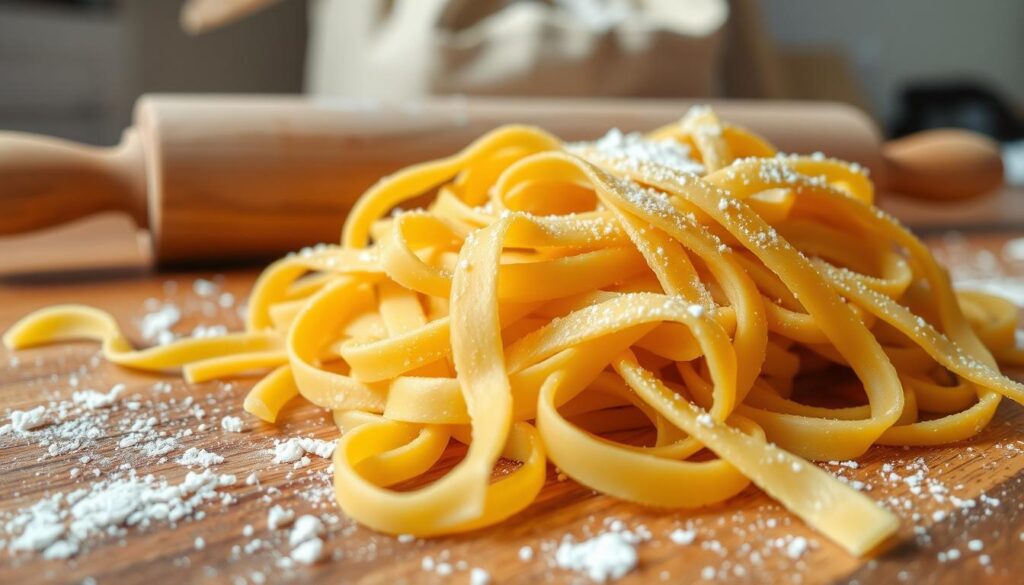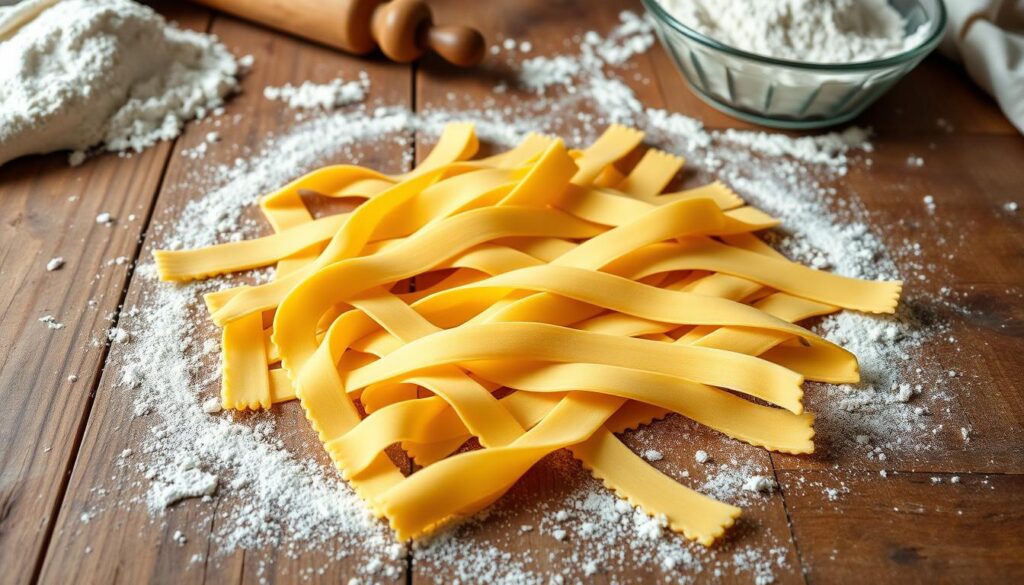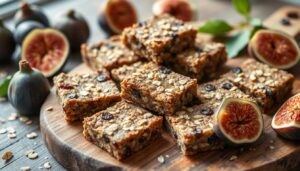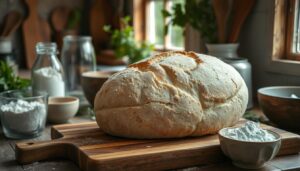Are you tired of store-bought gluten-free lasagna noodles that lack flavor and texture? Create your own delicious, oven-ready gluten-free lasagna noodles at home! This simple recipe needs just four ingredients, including water. It yields soft, pliable, and sturdy noodles that will change your lasagna experience.
Homemade gluten-free lasagna noodles taste better and feel better in your mouth than store-bought ones. They are a big win for celiac-friendly Italian dishes. These noodles work well in many lasagna recipes, from meat to vegetarian. The best part? They’re ready to go straight into the oven, saving you time and effort.
Table of Contents
Key Takeaways
- Homemade gluten-free lasagna noodles offer superior flavor and texture compared to store-bought options.
- This easy recipe requires just four ingredients, including water, for soft, pliable, and sturdy noodles.
- The noodles are oven-ready and don’t require pre-cooking, simplifying the lasagna assembly process.
- These versatile noodles can be used in a variety of lasagna recipes, including meat-based and vegetarian versions.
- Mastering homemade gluten-free lasagna noodles can take your Italian cuisine to new heights.
Understanding Gluten-Free Pasta Making Basics
Making your own gluten-free pasta at home is rewarding. It tastes better and feels better in your mouth than store-bought pasta. If you want a dairy-free lasagna option or an allergen-free lasagna, learning to make gluten-free pasta is essential. Let’s explore the basics to help you make perfect pasta.
Benefits of Homemade vs. Store-Bought Options
Homemade gluten-free pasta lets you choose what goes into it. This way, you can make it fit your diet perfectly. Plus, making it yourself means you can try different flours and get the texture just right. And, you’ll feel proud of making a delicious meal from scratch.
Essential Equipment and Tools
To make gluten-free pasta, you need a few important tools. A food processor is very helpful for getting the dough right. Also, a pasta roller (like the KitchenAid attachment) helps roll out the pasta thinly and evenly. But, you can also make it by hand with a rolling pin.
Key Success Factors
The key to great gluten-free pasta is the dough’s consistency. It should be firm, smooth, and slightly tacky but not too sticky. Getting this right makes the pasta easy to handle and cook. Also, using flour to dust the dough helps a lot during the making process.

“The homemade lasagna noodles recipe emphasizes the use of gluten-free flour blends from popular brands like Cup4Cup, Caputo Fioreglut, and King Arthur Measure for Measure.”
Essential Ingredients for Perfect Gluten Free Lasagna Noodles
Making gluten-free lasagna noodles is all about choosing the right ingredients. A top-notch gluten-free flour blend is key. It gives the noodles their structure and texture. Eggs, both whole and yolks, add moisture and help the dough stick together.
A little fine salt also goes into the dough. It boosts the flavor without overpowering it.
Cup4Cup Multipurpose Flour is a great choice for gluten-free pasta. It’s made from a mix of starches and whole-grain flours. This blend ensures the noodles are delicate yet strong.
The right mix of ingredients in this flour helps avoid noodles that are too crumbly or brittle. This is especially important for vegan lasagna noodles.
| Ingredient | Quantity |
|---|---|
| Gluten-Free Flour Blend | 1 to 1 1/2 cups |
| Eggs (whole or yolks) | 2 eggs or 4 yolks |
| Fine Salt | as needed |
| Water | 3/4 cup |
Getting the right mix of ingredients and using the right techniques is crucial. This way, you can make egg-free pasta option that’s both soft and strong. It’s perfect for a tasty gluten-free lasagna.

Best Gluten-Free Flour Blends for Pasta Making
Choosing the right flour blend is key to making tasty gluten-free lasagna noodles. Cup4Cup multipurpose flour and Caputo Fioreglut are top picks for their performance.
Cup4Cup flour is great for making pasta. It gets high marks for gluten-free lasagna noodles, with a 4.99 rating from 151 votes. Making this recipe takes 45 minutes, plus 5 minutes to cook.
Alternative Flour Recommendations
While Cup4Cup is excellent, other blends can also work well. King Arthur Measure for Measure is a good option. You might need to tweak the water to get the right dough.
Understanding Flour Properties
Different flours change the dough’s texture, so you might need to adjust the water. Knowing each flour’s unique traits is key for making great gluten-free pasta.
| Flour Blend | Key Properties | Recommended Uses |
|---|---|---|
| Cup4Cup | High-performing, versatile blend | Delicate recipes like pasta |
| Caputo Fioreglut | Contains gluten-free wheat starch, excellent texture | Pasta, pizza, and baked goods |
| King Arthur Measure for Measure | Requires slight water adjustments, versatile blend | Wide range of gluten-free recipes |
Knowing the special qualities of these flours lets you pick the best one for your pasta. This way, you can make delicious gluten-free pasta every time.

Step-by-Step Gluten Free Lasagna Noodles Recipe
Making homemade gluten-free lasagna noodles might seem hard, but it’s easy with the right steps. You can make delicious, safe noodles for your gluten-free dishes. Just follow a simple guide to get perfect noodles every time.
- In a food processor, mix 200g (7.1 oz) of gluten-free flour, 2 eggs, 2 tsp water, 2 tsp oil, and 1/4 tsp salt. Pulse until it forms a dough.
- Wrap the dough in plastic wrap and chill it in the fridge for 30 minutes. This lets the gluten-free flour soak up the moisture.
- Split the dough into 4 equal parts. Work on one part at a time, rolling it through a pasta machine. Start at the widest setting and get thinner with each pass.
- Use a pizza cutter to cut the dough into rectangular shapes that fit your lasagna pan. This gives you a clean, even cut.
The trick is to slowly add the gluten-free flour. Be patient and adjust the dough as needed. This will help you get the right texture for your homemade noodles.

By following these easy steps, you’ll have fresh, gluten-free noodles for your lasagna. Making your own pasta is rewarding. It makes your gluten-free lasagna even more special and comforting.
Mastering the Dough Consistency
Getting the dough right is key for gluten-free lasagna noodles. It should be smooth, firm, and easy to shape, like stiff play dough. If it’s too sticky, add more gluten-free flour. If it’s crumbly, add a little water.
Troubleshooting Common Dough Issues
Things like humidity, temperature, and flour types can mess with the dough. Here are some fixes for common problems:
- Sticky dough: Add gluten-free flour, like Pillsbury Gluten-Free All-Purpose flour or Better Batter Cup for Cup flour, a bit at a time.
- Crumbly dough: Mix in water, 1 tablespoon at a time, until it sticks together.
- Dough that’s too dry: Add a few drops of water and knead softly to moisten it.
Visual Indicators of Perfect Dough
Getting the dough right is crucial for gluten-free lasagna noodles. It should be smooth and form a tight ball without falling apart. This shows the flour and liquid are mixed well, and it’s ready to roll and cut.
Keep in mind, the dough might need tweaks based on humidity and flour type. Paying attention to how it looks and making small changes will help you make great allergen-friendly lasagna noodles.
Rolling and Cutting Techniques
Mastering the art of rolling and cutting is crucial for making gluten-free pasta for your lasagna. Start by setting your pasta roller attachment to the widest setting. Feed the gluten-free pasta dough through the rollers, folding it in half after each pass. This will help you achieve a smooth, even texture.
As you roll, gradually lower the roller setting. This will thin out the dough until it’s the right lasagna sheet thickness. Remember, thinner dough means a more delicate texture. Use a sharp knife or pizza cutter to cut the dough into rectangles for your lasagna.
Use a light dusting of gluten-free flour to prevent the homemade lasagna sheets from sticking. Try different pasta machine techniques to find what works best for you. With practice, you’ll soon be making professional-quality gluten-free pasta.
“The key to perfect gluten-free pasta is all in the technique. Patience and a light touch will yield delicate, restaurant-quality homemade lasagna sheets.”
| Ingredient | Quantity |
|---|---|
| Fine white rice flour | 300g |
| Tapioca flour | 75g |
| Psyllium husk powder | 20g |
| Boiling water | 150g |
Dough Consistency Tips
- The gluten-free pasta dough should be smooth and pliable, not too dry or sticky.
- Scalding the flour before adding the eggs is essential for developing elasticity in the dough.
- The pasta dough should be rolled thinly and to the shape of the baking dish for optimal results.
Storage and Make-Ahead Tips
Storing your gluten-free lasagna noodles right is key for safety and taste. You can chill or freeze them ahead of time. This makes prep work a snap when you need them.
Refrigeration Guidelines
Keep your noodles in the fridge for up to 3 days. Just dust them with gluten-free flour, stack, and wrap with plastic. This keeps them fresh and prevents sticking.
Freezing Methods
To freeze, lay noodles flat on a baking sheet and freeze for 2 hours. Then, move them to a sealed container or bag. They’ll stay good in the freezer for 3 months.
It’s important to store them right because of the egg in the dough. By following these tips, you can enjoy your gluten-free pasta and lasagna noodles for months. Meal prep becomes easy.
Using Fresh Noodles in Lasagna Assembly
Making a tasty gluten-free lasagna is easy with homemade fresh pasta noodles. These noodles are ready to go straight into the oven, saving you time. When you layer your gluten-free lasagna, make sure each noodle is covered in sauce. This keeps the lasagna moist while it bakes.
To build your lasagna, layer fresh pasta in lasagna, sauce, and cheese. The oven-ready noodles will cook just right. For thicker noodles, a quick boil before assembling is a good idea.
- Spread a thin layer of sauce on the bottom of your baking dish.
- Arrange a single layer of fresh gluten-free lasagna noodles, overlapping slightly if needed.
- Top the noodles with a generous portion of your desired sauce and cheese mixture.
- Repeat the layers of noodles, sauce, and cheese until you reach the top of the dish.
- Finish with a final layer of noodles, sauce, and a sprinkle of cheese.
Using homemade gluten-free noodles makes your lasagna truly special. You’ll get a perfect mix of flavors and textures in every bite.
“The fresh noodles make all the difference in this lasagna – they cook up perfectly every time, and the texture is just divine.”
Tips for Perfect Texture and Taste
To get the perfect texture for your gluten-free lasagna, start with the dough. Make sure to knead it well and chill it in the fridge. This makes the dough easier to work with and more hydrated.
When rolling out the noodles, use a little flour to prevent sticking. This helps ensure the sheets are even in thickness.
For the best taste, cover each layer of lasagna with plenty of meat sauce. This adds flavor to the noodles and helps them cook evenly. After baking, let the lasagna rest for 20 minutes before slicing.
This resting time lets the layers set, giving you a firm yet delicate texture. It also enhances the flavors.
If you want a dairy-free lasagna, use vegan ricotta made from cashews or tofu. For the mozzarella, choose plant-based shredded cheese that melts well. With these changes, you can enjoy a gluten-free and dairy-free lasagna that’s just as good as the traditional one.
FAQ
What are the benefits of homemade gluten-free lasagna noodles compared to store-bought options?
Homemade gluten-free lasagna noodles taste better and feel softer than store-bought ones. They need just four ingredients, including water. These noodles are perfect for lasagna, blending well with other ingredients.
What essential equipment is needed to make homemade gluten-free pasta?
You’ll need a food processor and pasta roller to make homemade pasta. You can also do it by hand. Tools like a Cuisinart food processor and KitchenAid pasta attachment are recommended.
What are the key success factors for making perfect gluten-free lasagna noodles?
To make great noodles, get the dough right and roll it well. The dough should be firm, smooth, and slightly tacky.
What are the recommended gluten-free flour blends for making homemade pasta?
Cup4Cup multipurpose flour is top-notch for making pasta. Caputo Fioreglut and King Arthur Measure for Measure are good too, but might need a bit more water.
How do you achieve the perfect dough consistency for gluten-free lasagna noodles?
Aim for a dough that’s smooth and firm, like stiff play dough. If it’s too sticky, add flour slowly. If it’s too crumbly, add water a little at a time. The dough should form a ball easily and have a smooth surface.
What is the process for rolling and cutting the gluten-free lasagna noodles?
Start with the pasta roller on the widest setting. Roll the dough through several times, folding it in between. Keep decreasing the setting until you get the right thickness. Then, cut the dough into rectangles for your casserole.
How should homemade gluten-free lasagna noodles be stored?
Keep fresh noodles in the fridge for up to 3 days. For freezing, lay them flat and stack them in an airtight container. Use frozen noodles within 3 months. Storing them right is important because of the egg in the dough.
Do homemade gluten-free lasagna noodles require pre-cooking before assembly?
No, you can bake them straight from the package. Make sure each noodle is covered with sauce to keep it moist during cooking.
How can you achieve the perfect texture for homemade gluten-free lasagna?
Get the dough right, chill it, and dust it lightly to prevent sticking. Covering the noodles with sauce is key. Let the lasagna rest for 20 minutes after baking for the best texture and flavor. For dairy-free, use vegan cheese.



